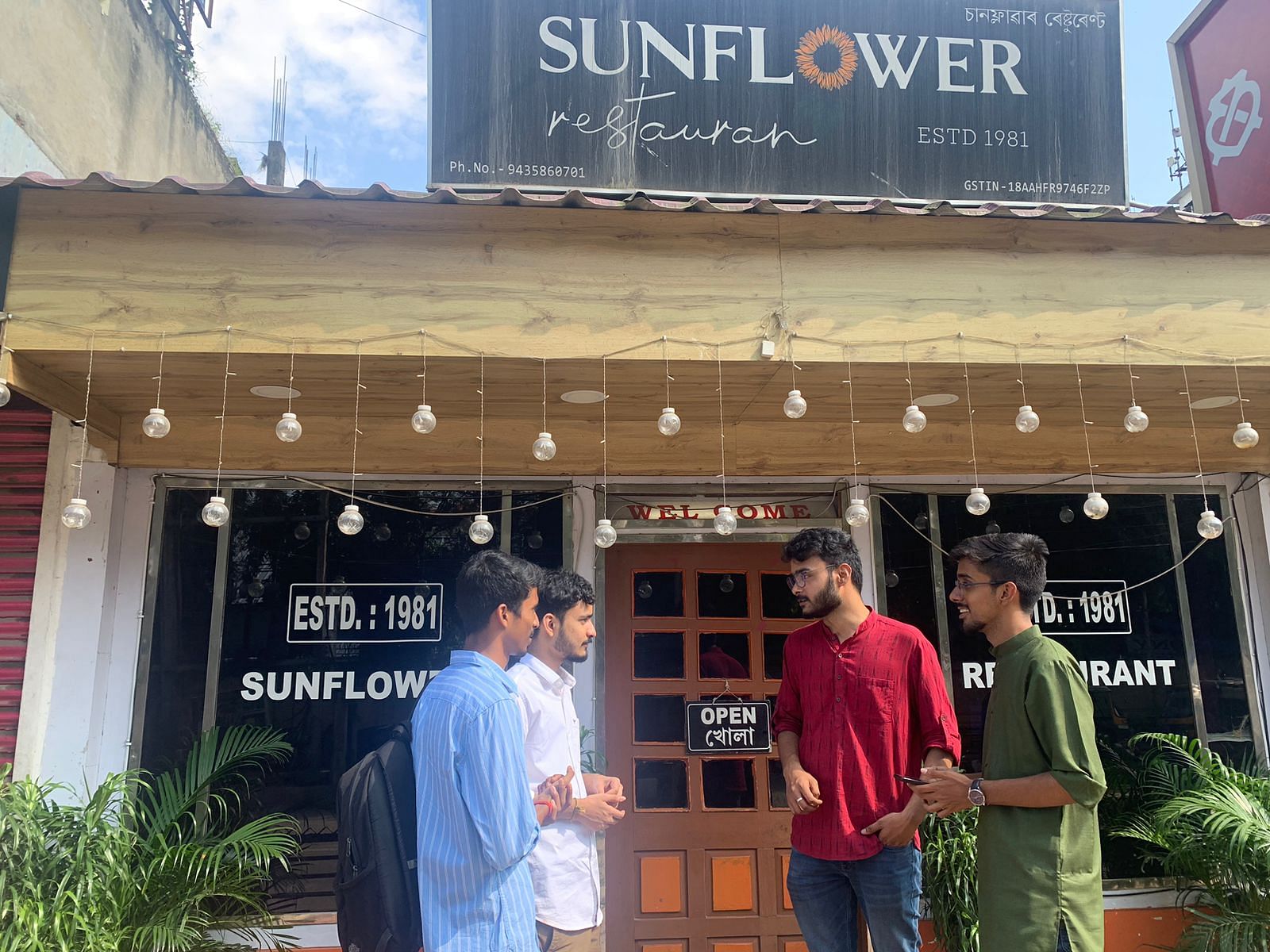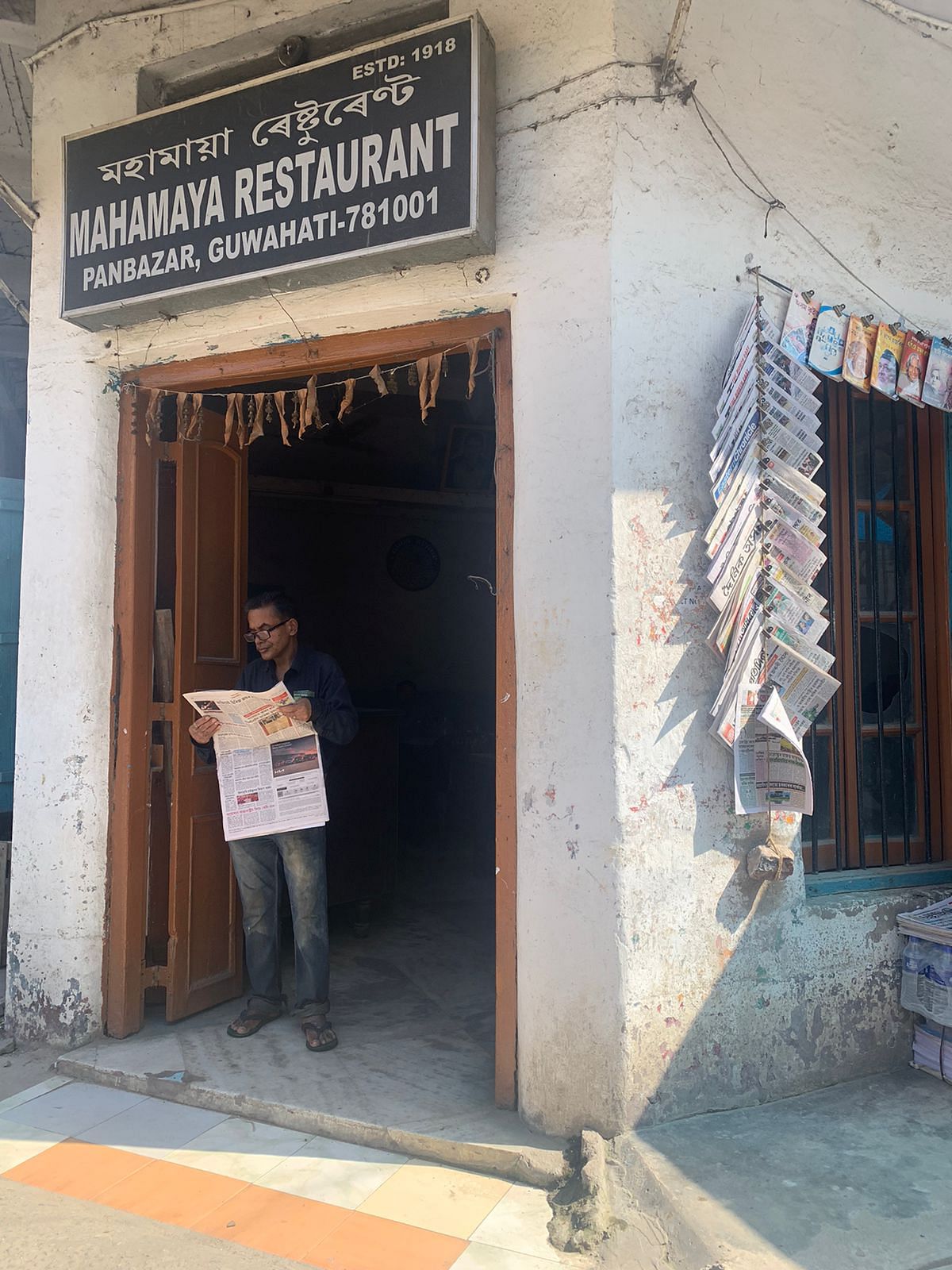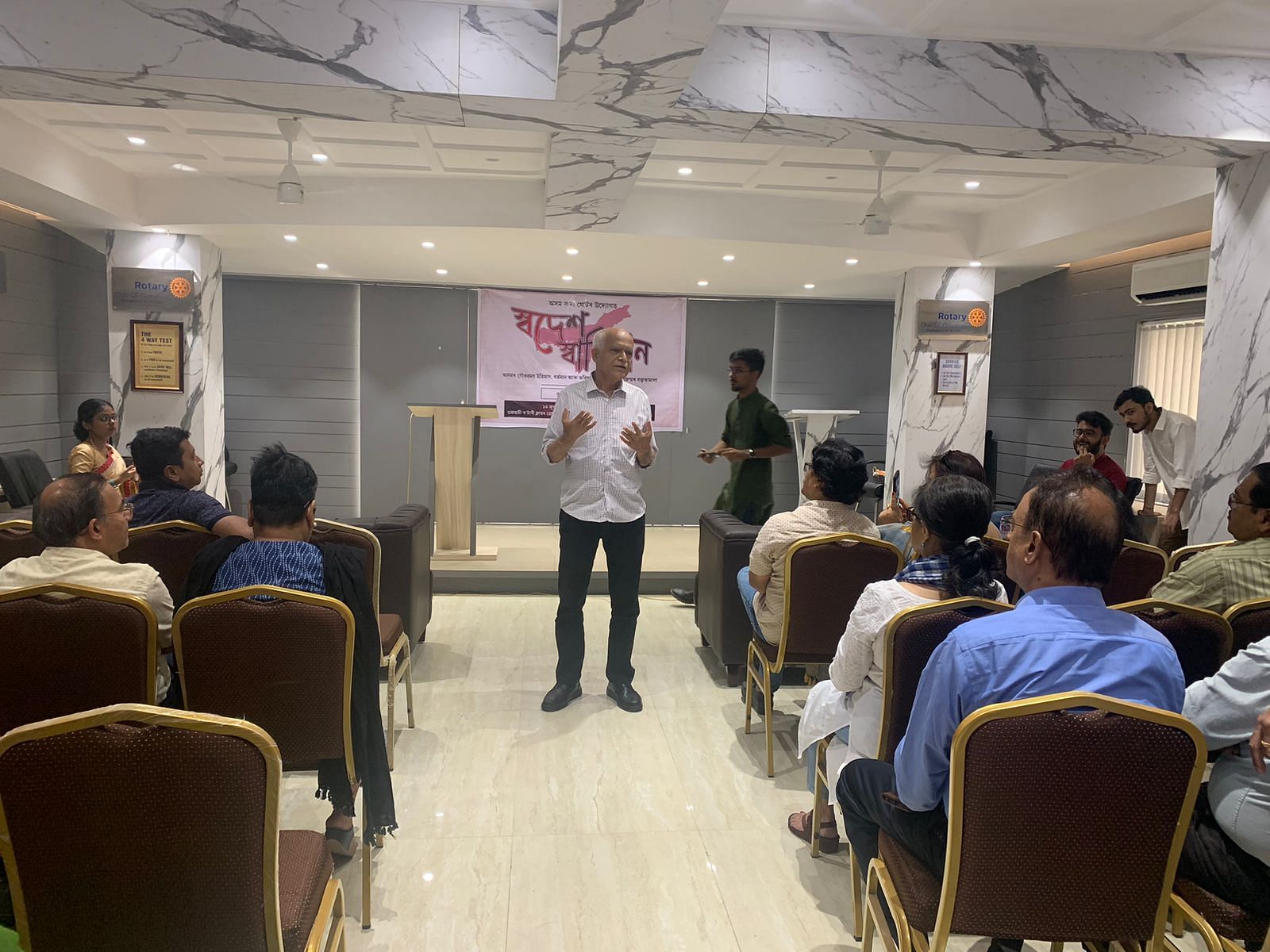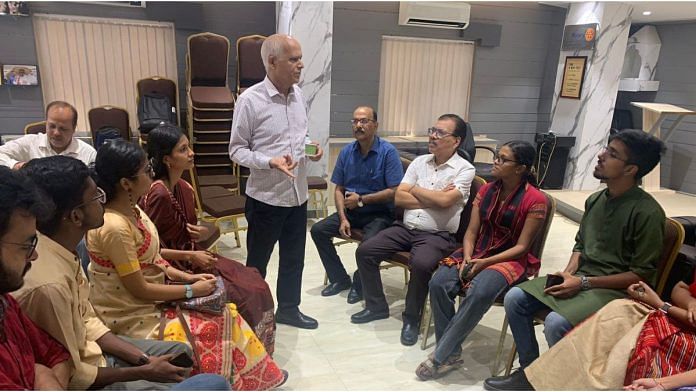Guwahati: Sudarshan Kaushik Sharma stepped onto the podium and set aside the faulty mic to speak his truth about Guwahati, the city he calls home. It’s worse off than the over 4,500-year-old Harappa, he suggested.
“Let’s tell you the difference between a planned and an unplanned city—Harappa, with an elaborate drainage system, and Guwahati, where we have only just begun to think of drainage plans,” said Sharma. The audience nodded in agreement.
Dressed in jeans and a black T-shirt with “Notunor Agaman” (Advent of the New) scrawled on the back, Sharma wouldn’t be out of place in a college campus, a cafe, or even at a pub. Instead, he’s in a brightly lit room at the Rotary Club in Guwahati’s Panbazar, discussing the city’s future with senior citizens, professionals, and students.
In most cities, from Bengaluru to Mumbai, senior citizens drive civic reform and debate, but in Guwahati, students are flipping this stereotype. Sharma is part of Asom Kotha, a new group of around 40 students who want to collaborate with residents and civic authorities to improve their city. Asom Kotha is an expression of both city pride and the youth’s frustration with Guwahati’s failure to live up to its imagined promise.
“Despite the development, Guwahati hasn’t been the ‘smart city’ as envisioned. We don’t have the amenities and services we need”
– Sudarshan Kaushik Sharma, a student part of Asom Kotha
The group is calling for more libraries, more parks, more green spaces, and sustainable development, using the good old-fashioned adda sessions to spread the word. It has taken charge of organising the ‘Swadesh Swabhiman’, a multi-venue conclave started by Assam’s oldest literary body, the Asam Sahitya Sabha, in 2021. Any organisation can host the Swadesh Swabhiman, with Asom Kotha conducting its first conclave on 13 July.
Sharma was speaking at this conclave, titled ‘Guwahati Guwahati’, attended by over 50 people, including retirees, professionals, and students.
“Despite the development, Guwahati hasn’t been the ‘smart city’ as envisioned. We don’t have the amenities and services we need,” said Sharma, comparing the malfunctioning mic and the poor audio system to the state of development in Guwahati. “Despite the advances in technology, the microphone malfunctioned,” he added.
Asom Kotha was launched four months ago under the guidance of retired Assam DGP Kuladhar Saikia, who was also the former president of the Asam Sahitya Sabha.
“I thought of a platform that would enable the youth to research and debate on themes of public life, enabling them to not only think about certain issues in detail, but also inspire new topics for discussion,” said Saikia.
“Hobo Hobo”
With few government-run youth centres in town, Asom Kotha resonates among local residents. Members pitch ideas for debates and adda sessions on their WhatsApp group, covering topics from history, nostalgia and culture to traditions, food habits, and folklore. Heritage, sustainable development, and civic infrastructure are evergreen themes.
When student Tridib Bhagawati suggested organising a Swadesh Swabhiman, the group enthusiastically agreed. “Hobo Hobo (Certainly, it will be done!),” responded one member.
At the Swadesh Swabhiman, eight students took turns speaking about Guwahati’s future. The day before, they met with Saika at the iconic Sunflower restaurant for an evening adda over pakoras and coffee.

The group aims to extend the Swadesh Swabhiman platform across Assam.
“We want to hold consultations with society, make our voices heard, and find ways to take things forward,” said Hrishikesh Goswami, a student from Cotton University.
At the session, Goswami discussed how rapid development is robbing young people of open spaces to meet and “gossip”. A bone of contention is the issue of newly built parks near the Brahmaputra river charging entry fees of Rs 100.
“The new parks are not economical for students. Our pocket money doesn’t allow us to purchase tickets every day or convene adda sessions there. Gossip is essential to keep people sane. With development, we have lost spaces for such purposes,” said Goswami.
The speeches were more than tinged with nostalgia. Mahamaya Cabin at Panbazar, located a few meters away from the Rotary Club, was mentioned. The tea tables at Mahamaya weren’t just spots for exchanging pleasantries, but also meeting points where people shared stories and ideas.
Swadesh Swabhiman was started around November 2021. Though the literary body was started by young Assamese students in Calcutta in 1917, there was a general feeling that youth have not been given a proper platform
– Former Assam DGP Kuladhar Saikia
The old tea shop and restaurant, built in 1918, still sells tea, sweets, omelettes, and pulao—but the addas have disappeared.“Sadly, Mahamaya is now only a bhojanalaya (restaurant),” said Dorothy Bora, a student from Cotton University.
Others shared their fondness for the bread and cakes of Shaikh Brothers, a bakery established in 1885, which still has a regular clientele.
“It depends on how you perceive addas. Many students consider it a waste of time, but it is social discourse that once shaped the cultural growth of Assam,” said 21-year-old Bornil Medhi, a graduate of Delhi’s Hindu College.

Emergence of Asom Kotha
As a youth club of sorts, Asom Kotha serves a dual purpose of engaging students in participatory civic activism and community building while also honing their public speaking skills.
For Saikia, it is a way of keeping alive the initiatives he launched as the president of the Sahitya Sabha from 2020-23.
“Swadesh Swabhiman was started around November 2021. Though the literary body was started by young Assamese students in Calcutta in 1917, there was a general feeling that youth have not been given a proper platform,” said Saikia.
Around 18 sessions have been organised in the past three years, even in mofussil towns like Jorhat and Lakhimpur in Upper Assam, to enhance emotional intelligence and confidence building. Members are now seeking to organise Swadesh Swabhiman sessions at least once every month.
Also read: The many avatars of Manoj Soni—‘Chhota Modi’, UPSC chairman, now monk in obscure sect
‘Guwahati can never be Mumbai’
The cityscape looks splendid with the Neelachal hills at the horizon and the river Brahmaputra gleaming like a jewel under the sunset sky. At night, the city sparkles with a million twinkling lights.
After the peak insurgency during the 1990s, Guwahati is slowly discovering a nightlife. The ‘smart city’ is learning to stay up until late hours, which many view as a welcome change from the decades when people would return home by sunset—out of fear.
Being the gateway to the Northeast, Guwahati has become a magnet for investors, making rapid advances in infrastructure development, tourism, and even the IT industry. But these winds of change have local residents worried.
“The development projects have not been gradual or sustained, but sudden. These changing times have led to a surge in prices, and a gradual socio-demographic transformation,” said one of the speakers.

The students questioned if there was a plan or roadmap to accommodate the city’s burgeoning population.
“What about the drainage system, drinking water issues, garbage disposal, and proper channelling of the Brahmaputra and Bharalu river water?” asked Anol Ankush Bora from Gauhati University.
He described the capital city as one that rapidly transformed from the ‘Xopun Nogori’ (land of dreams) nurtured by blood, sweat and tears to a ‘Bharakanta Nogori’ (overburdened land).
Today, Guwahati has more than 20 flyovers, with at least two more under construction.
Assam’s Budget for 2018-19 allocated Rs 150 crore for the construction of the Panbazar-Guwahati-North Guwahati Bridge across the Brahmaputra River, part of which was opened to the public this year. But in April, the non-governmental Citizen Coordination Committee of Guwahati held a protest demonstration, alleging that the bridge has increased traffic congestion.
In January, Union Home Minister Amit Shah inaugurated the Brahmaputra Riverfront Development project at Panbazar, which is expected to cost over Rs 308 crore. The government hopes to transform a 6-km stretch of the riverfront to promote tourism and local businesses. But many participants questioned whether they would actually benefit from this, or the high cost of development.
“The old spirit of Guwahati just doesn’t exist anymore. When we construct newer spaces, we need to understand the concept of planned and unplanned development, and what lies in-between. Guwahati can never be Mumbai”
– Tridib Bhagawati, a student from Cotton University
One participant highlighted data compiled under the Global Forest Watch, a real-time monitoring initiative of the US-based World Resources Institute, on depleting forest cover. In 2010, Assam had 2.38 million hectares of natural forest, extending over 33 per cent of its land area. By 2023, it had lost 17.1 Kha (or 17,100 hectares).
Tridib Bhagawati, from Cotton University, remembered the time when Guwahati hills were cohabitated by a healthy population of leopards.
“The area near Birubari and Bhangagarh used to be a tribal belt. But now with haphazard construction, there are no hills left for animals. I have seen the destruction before my eyes,” he said.
On 24 July, it rained for an hour and a half, and all the familiar areas of Assam’s capital city were flooded. The situation became worse last Monday when autos and scooters overturned on waterlogged lanes, school children and buses remained stuck in traffic for hours, and boats had to be deployed for rescue purposes. Last month, an 8-year-old boy was swept away by flood waters in the Kamrup Metropolitan district. His body was recovered from a drain three days later.
Asom Kotha wants all this to be a part of public discourse. Its members support infrastructure and tourism initiatives, but want planning and development to be Guwahati-centric, rather than mere copy of some other city’s blueprints.
“The old spirit of Guwahati just doesn’t exist anymore,” said Tridib. “When we construct newer spaces, we need to understand the concept of planned and unplanned development, and what lies in-between. Guwahati can never be Mumbai.”
(Edited by Aamaan Alam Khan)






